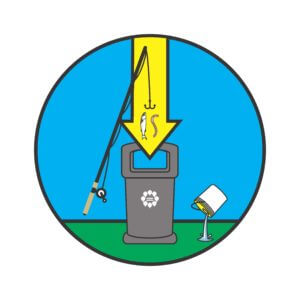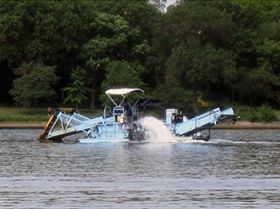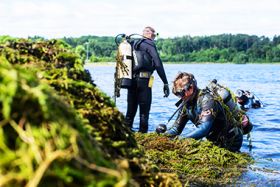- Delay the introduction of AIS into Minneapolis water bodies as long as possible in hope that techniques are developed to control or reduce their impacts.
- Educate boaters and Minneapolis park patrons on AIS prevention and their potential impacts to recreation.
- Collect data on lake usage to help form a recommendation to the Board on what AIS prevention actions will be taken in the future.
The Threat
Minnesota’s waterways are threatened by aquatic invasive species (AIS). AIS are plants, animals, and pathogens that are not native to Minnesota. Once established in local waterbodies, AIS can cause economic and environmental damage as well as harm to human health.
Once an AIS is established in a new water body it is nearly impossible to eliminate. This means the most effective way to limit the impacts of AIS is to prevent their spread and establishment. The Minneapolis Park and Recreation Board (MPRB) prioritizes AIS prevention efforts to better ensure that our shared water resources can be enjoyed for years to come.
2024 Boat Launch AIS Inspection Hours
In April 2013 the MPRB implemented a Watercraft Inspection and Education Program. Since then, all watercraft and water-related equipment that use the Bde Maka Ska, Lake Harriet, and Lake Nokomis boat launches from May 1 to December 1 of each year must undergo an aquatic invasive species (AIS) watercraft inspection. The boat launches are locked and unavailable to the public unless the Inspectors are onsite. The 2024 boat launch hours are:
May 1 – September 2
Daily: 6 am–10 pm
September 3 – October 14
Daily: 6 am–9 pm
October 15 – November 3
Daily: 7 am–8 pm, Inspector On-Call*
November 4 – December 1
Daily: 8 am–6 pm, Inspector On-Call*
During our fall on-call inspection program please call the following numbers to get an inspection.
- Bde Maka Ska (formerly Lake Calhoun): 612-346-5547
- Lake Harriet: 612-346-5433
- Lake Nokomis: 612-346-5428
Boat launches will be opened for each boater who calls for entry and exit inspections. Wait time is generally less than 10 minutes. Appointments not accepted. Boaters not exiting the lake by closing time must secure their boat and return for it the next day.
What You Can Do to Help
Recreational lake users are responsible for preventing the spread of AIS. Here are a few precautions you can take in order to do your part:
Clean, drain, and dry your watercraft and water-related equipment
According to Minnesota law, it is illegal to transport aquatic plants and prohibited invasive animals as well as water to and from water bodies. Additionally, the Minnesota DNR recommends that you spray your watercraft with hot, high-pressure water and let it dry for at least five days before going to a new water body. For more information, visit the DNR’s website.
Dispose of your unwanted bait
It is illegal to release bait into a water body or release prohibited invasive aquatic animals from one water body into another. Dispose of unwanted bait in a garbage can before leaving the lake. If you want to keep your bait, you must drain all water from your bait containers and replace the water with bottled or tap water. You may see garbage cans around Minneapolis with these stickers as a helpful reminder:

Obtain a SCUBA permit
If not properly cleaned, drained, and dried, SCUBA diving equipment has the potential to spread aquatic invasive species between waterbodies. Once a lake is infested with zebra mussels or other invaders, SCUBA diving can be hindered by increased plant growth, dense mussel growth on underwater attractions, and sharp mussel shells that may damage dive clothing and equipment. If you plan to SCUBA dive on any MPRB waterbody, you must first obtain a no-cost permit and take the necessary precautions to prevent the spread of AIS.
- SCUBA and Aquatic Invasive Species Brochure [PDF]
- SCUBA Permit Frequently Asked Questions [PDF]
- Apply for a SCUBA diving permit
Report new sightings of AIS
If you suspect that you have found a new infestation of an invasive plant or animal, take note of the location, save a specimen, and report it to one of the DNR’s Central Region Aquatic Invasive Species Specialists.
Enforcement
Under Minnesota law, it is illegal to transport aquatic plants and prohibited invasive animals as well as water to and from water bodies. Failure to comply with Minnesota AIS regulations can result in fines up to $500.
For more information about AIS laws and penalties:
AIS Early Detection
MPRB uses a variety of early detection techniques to search for newly established
populations of AIS in Minneapolis lakes and streams. Some of the techniques are specific to zebra mussels while others can detect a variety of plant and animal invaders.
Zebra Mussel Settling Plates
Zebra mussel settling plates are devices that are hung from docks and used to detect zebra mussels after they complete their juvenile veliger life stage. MPRB staff and volunteers from the Friends of Lake Nokomis monitor zebra mussel settling plates at the following lakes: Wirth, Cedar, Lake of the Isles, Bde Maka Ska, Harriet, Nokomis, and Hiawatha.
Zebra mussels have only been detected at Lake Hiawatha using this method. This is
expected since Lake Hiawatha has been heavily infested with zebra mussels for several years. Despite this, a settling plate continues to be deployed in Lake Hiawatha to monitor the
population.
Buoy Inspections
Similar to settling plates, beach buoys and sailboat buoys serve as suitable growing surfaces for zebra mussels. MPRB watercraft inspectors inspect beach buoys from Cedar Lake, Bde Maka Ska, Lake Harriet, Lake Hiawatha, and Lake Nokomis after they are removed from the lakes in the fall. Zebra mussels have only been observed on the Lake Hiawatha beach buoys.
Zebra Mussel Veliger Sampling
MPRB staff use nets to search lakes for juvenile zebra mussels called “veligers” during late summer months. The nets collect water samples which are sent to a specialized laboratory that can search for veligers using microscopes. Zebra mussel veliger sampling was not conducted in 2022.
Weekly Boat Launch Surveys
Once per week from June to September, specially trained staff conduct surveys of the boat launches at Bde Maka Ska, Lake Harriet, and Lake Nokomis. The surveys involve entering the water while wearing waders and a life jacket to inspect the dock, the boat ramp, plants, rocks, sticks, and other debris for approximately a half hour. The staff use the surveys to look for a variety of plant and animal AIS. No unexpected AIS have been observed during the surveys.
Eurasian Watermilfoil Delineations
MPRB staff delineate Eurasian watermilfoil at Wirth Lake, Cedar Lake, Lake of the Isles, Bde Maka Ska, Lake Harriet, and Lake Nokomis in late August or early September. For all the surveys except Wirth Lake, staff boat around the entire perimeter of each lake and periodically collect rake toss samples of the aquatic plant community. The Wirth Lake delineation is limited to a small portion of the lake and is conducted on foot from the shoreline. During all delineations, relative abundancies of native and invasive plant species are determined via visual observation and rake toss sampling and recorded on a lake map. No new invasive aquatic plant species have been detected.
SCUBA Survey
Staff from MPRB and Blue Water Science conduct surveys for zebra mussels on one MPRB lake each year. Blue Water Science utilizes SCUBA during the survey while MPRB staff check rocks and other substrate along the shoreline using waders.
Environmental DNA (eDNA) Study
MPRB staff conduct environmental DNA (eDNA) monitoring at seven lakes in late summer. Five or ten sample sites are identified per lake and are distributed among inlets, outlets, boat launches, fishing piers, and other noteworthy locations. All the samples from a single lake are passed through the same 10μm nylon filter.
All samples are filtered by MPRB staff and sent to a molecular biology laboratory for analysis. The samples are analyzed for zebra mussel and quagga mussel DNA using quantitative polymerase chain reaction (qPCR). The only samples that have tested positive for zebra mussel DNA were those collected from Lake Hiawatha. No samples have tested positive for quagga mussel DNA. Environmental DNA sampling was not conducted in 2022.
Summary
MPRB uses a suite of early detection tools to search for zebra mussels and other AIS. Early detection techniques have not detected any new AIS infestations, and only found zebra mussels in Lake Hiawatha – a lake that is already known to have an established population. That said, it is nearly impossible to prove that zebra mussels are not in a lake, so MPRB plans to continue treating Bde Maka Ska, Lake Harriet, and Lake Nokomis as if they are infested with zebra mussels. This will help prevent the spread of zebra mussels to other lakes.
AIS Management

Mechanical Harvester
Harvesting
Harvesting is currently the best management option that the MPRB has to control aquatic plants, including Eurasian watermilfoil, an aquatic invasive species that is prevalent in many Minneapolis lakes. Minnesota DNR-issued permits limit the area of milfoil that can be harvested each year. Harvesting is done primarily in swimming areas and around boat launches. A machine called a mechanical harvester removes plants that are in the top six feet of water. This temporarily allows for trouble-free boating and swimming and allows sunlight to penetrate to native plants below.
For more information about MPRB’s aquatic plant management efforts, check out the Aquatic Plant Management page.

Frequently Asked Questions
What are the goals of MPRB’s Watercraft Inspection & Education program?
Why is the Park Board concerned about AIS?
AIS threaten native plants and animals, which in turn alters the lake’s ecology. These changes can significantly interfere with both the beauty and recreational use of lakes. Some AIS, e.g. zebra mussels, can also have human health impacts, such as cutting the feet of swimmers on beaches.
Isn't it too late to prevent the spread of AIS?
No. While the lakes are already affected by some AIS, including Eurasian watermilfoil, there are still many species, with far worse impacts, that can be prevented from entering and harming the lakes. States that have implemented similar AIS prevention programs have significantly slowed the spread of AIS.
Which AIS is the Park Board aiming to keep out of Minneapolis lakes?
The MPRB is focusing its prevention efforts against many invasive species of plant, animal and pathogen, including many that currently do not occupy Minneapolis lakes, but are present in other bodies of water that Minneapolis lake visitors frequent. Fortunately, cleaning, draining, and drying watercraft and water-related equipment is an effective way to prevent the spread of all AIS. Learn more about AIS from the Minnesota DNR.
How does the AIS education and inspection program affect canoes, kayaks and sailboats?
The program focuses primarily on trailered boats accessing the lake through the public launches.
Canoes and kayaks entering the lake from storage racks, or watercraft carried over the shoreline at other access points will generally not require an inspection. However, if the inspectors have reason to believe that your canoe or kayak is transporting AIS, they have the authority to stop you and perform an inspection. If you are not sure whether your canoe or kayak is an AIS transporting risk or not, feel free to ask the inspectors for a courtesy inspection. They would be happy to teach you how to inspect your watercraft.
All sailboats that use the trailered public boat launches will be subject to an inspection. Additionally, all sailboats (including trailers, dollies, and gear) participating in permitted regattas must be inspected when entering and exiting the water, even if they are accessing the lake over the shore rather than the boat launch.
How are the boat launch hours determined?
How long do inspections take?
Most inspections are completed in less than five minutes. However, inspections may take longer if the watercraft or water-related equipment requires cleaning. The best thing you can do to streamline your inspection is arrive to the boat launch with a clean boat, trailer, etc.
What if I refuse to have my boat inspected?
Boaters who refuse inspections will be denied access to the lake. Additionally, they may be issued a civil citation to remove their watercraft license for up to one year. More information about AIS laws can be found in the “Enforcement” section above.
Which lakes or water bodies are affected by the AIS inspections?
MPRB staff perform AIS inspections at the Bde Maka Ska, Lake Harriet, and Lake Nokomis public boat launches.
What if I want to go fishing on the lakes before the launch opens or after it closes?
Can I use my gas-powered motor on any of the lakes?
No. Gas-powered motors are not allowed on Minneapolis city lakes; only electric trolling motors are allowed. If you have a gas-powered motor on your boat, it must be propped up and out of the water. Boats that are using gas-powered motors without a permit will be reported to law enforcement.
What is proper bait disposal and how does it protect against AIS?
Most bait species are not native to Minneapolis lakes, so releasing them into the lakes could disrupt the local ecosystems. The MPRB and DNR encourage anglers to dispose of live bait in the well-marked trash receptacles available at boat launches, fishing docks, and high-use shoreline fishing areas throughout the park system. It is illegal to release live bait into a water body as well as to transport water from one water body to another.
Have zebra mussels infested the Minneapolis lakes?
Bde Maka Ska, Lake Harriet, Lake Nokomis, and Lake Hiawatha are all officially designated as infested with zebra mussels by the DNR. The lakes were given those designations due to either previous discoveries of zebra mussels or connectivity with an infested stream. One adult zebra mussel was found in Lake Harriet in 2017 and two juvenile zebra mussels were found at Bde Maka Ska in 2018. No zebra mussels have ever been found at Lake Nokomis but it is designated as infested due to its connectivity with Minnehaha Creek. Lake Hiawatha has a well-established zebra mussel population.
Using all of the early detection tools at our disposal, MPRB and DNR staff have not been able to locate an established zebra mussel population in the Chain of Lakes or Lake Nokomis. At this time, it appears that Lake Hiawatha is the only lake in Minneapolis with an established population of zebra mussels. It is important that boaters continue to prevent future introductions of zebra mussels and other AIS by cleaning, draining, and drying their watercraft and water-related equipment and properly disposing of unwanted bait.
Are MPRB staff taking any precautions to make sure that they are not spreading zebra mussels and other AIS to new Minneapolis lakes?
MPRB has many staff who spend their time in and around the Minneapolis lakes. These staff include Aquatics staff who serve as swimming beach lifeguards, Environmental Management staff who monitor lake water quality, Maintenance staff who maintain sailboat buoys, etc. The MPRB has developed a Zebra Mussel Action Plan [PDF] to guide the organization on prevention efforts against further infestations. The Zebra Mussel Action Plan has a section devoted to each of the main work groups who operate near the lakes.
Additionally, MPRB has an interdepartmental AIS work group that has met several times per year since 2012. The AIS Work Group discusses the status of AIS in Minneapolis water bodies and attempts to identify vectors that may introduce new AIS to Minneapolis lakes.
Where can I learn more about AIS?
The following resources are full of aquatic invasive species information:







